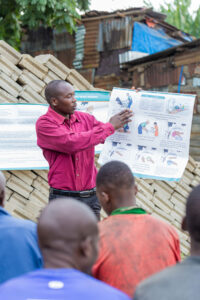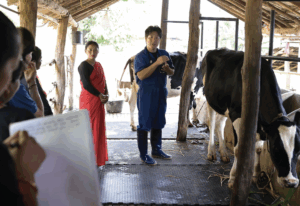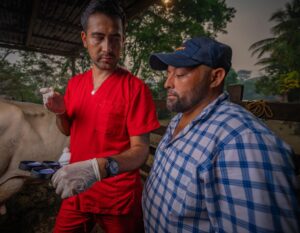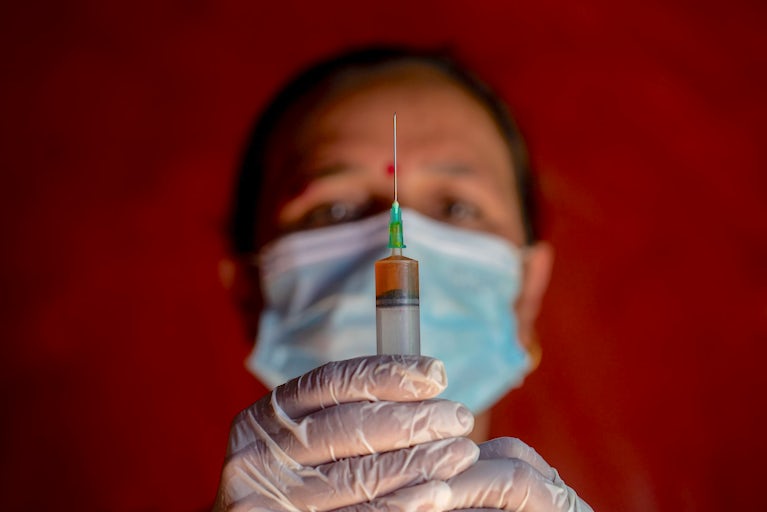An estimated 600 million low-income smallholder farmers globally earn their primary livelihood from raising livestock. Yet often they do not have access to quality veterinary care, which boosts food security and helps ensure not only the health of animals but also the well-being of communities and the environment.

Heifer International has decades of experience providing expertise in animal health, including training community animal health workers to extend veterinary care to rural communities and build local animal health capacity.
This locally led approach helps communities manage risks such as disease outbreaks, which can endanger the livelihoods of people who often cannot afford to replace their livestock when they fall ill.
Community animal health workers are community members who develop localized veterinary knowledge on disease treatment, preventative health care, animal nutrition and breeding. These trained experts make regular farm visits in their communities, providing low-cost care, such as vaccinations, deworming, artificial insemination and parasite control, as well as other extension services.
They are also trained in the connections between animal health and the health of people and the environment, an approach called One Health that is a central to sustainable livestock production. Environmentally responsible livestock management can contribute positively to reducing greenhouse gas emissions, regenerating degraded landscapes and improving animal health, while addressing household nutritional needs and increasing incomes.
By developing skills to bolster animal health and recognize and treat animal diseases, community animal health workers serve as critical front-line responders to help smallholders safeguard the health of their animals — and therefore secure their livelihoods and food security.
Considering that global policy and donor support for the livestock sector is less than 1 percent of overseas development assistance, Heifer’s work building community animal health capacity is especially important. It is vital to building rural resilience and program sustainability, ensuring communities have the resources they need to protect productive livestock livelihoods.
A Case Study: Disease Control in Nepal
Community animal health workers, in conjunction with Heifer Nepal, government authorities and other veterinary experts, were vital to stopping the spread of lumpy skin disease — a disease in cattle that can cause a reduction in milk production, temporary or permanent sterility in bulls, and death — which was detected among cattle in Nepal beginning in 2020.
The outbreak threatened a herd of Holstein heifers which were brought to the country from Korea through Heifer’s Milky Way Signature Program, a partnership between the governments of Nepal and Korea and Heifer International to transform Nepal’s dairy sector through a new model of smallholder dairy husbandry.
The program’s Model Dairy Village in Sindhuli, Nepal, the community of smallholder dairy farmers which received the cattle from Korea, plays an important role in improving local veterinary capacity for the animals by implementing field training in health management and biosecurity. However, as the outbreak of lumpy skin disease worsened nationwide, the program team feared devastating loss.

By July 2023, the disease had already infected approximately 1 million animals in Nepal, caused more than 48,000 deaths and cost an estimated loss of over 27 billion Nepalese rupees (around $200 million).
The Milky Way program team mobilized a robust response, working alongside farmers, local and national officials and veterinary providers to maintain biosecurity measures, manage infected animals and implement a public awareness campaign to stop the spread of the disease through the Model Dairy Village.
“I feel very lucky to have [24/7] technical assistance,” said Shanta Thapa, a resident of the Model Dairy Village who has cows from South Korea. She has called on the services of experts for a range of animal health problems, including lumpy skin disease.
Ultimately, the quick action and measures implemented by the program’s veterinary experts and community animal health workers saved the lives of many animals. Only five Korean cattle out of a herd of 80 died, preserving the program’s important efforts to grow the number of the high-producing breed in a sustainable manner and providing a model for future outbreak management around the world. Read more about the Milky Way program here.
A Global Approach

Globally, Heifer has trained more than 2,000 community animal health workers on veterinary health principles since 2008, and our years of expertise in this work has been recognized by the World Organization of Animal Health (WOAH), the global authority on animal health.
Starting in 2023, Heifer Senior Director of Programs Dilip Bhandari served on the WOAH AdHoc committee for the development of competency and curriculum guidelines for community-based animal health workers, which were approved by member states for global implementation and released in 2024.
“I was proud to bring Heifer’s expertise to this global effort, which will ensure the practices we’ve been using successfully for decades to protect animals, people, the environment and food security can reach an even larger number of livestock farmers,” Bhandari said.
In line with the principles of One Health, management of livestock diseases is pivotal to food security, with outbreaks disrupting the food supply chain, as seen during the lumpy skin disease crisis in Nepal. Especially as climate change worsens, ecosystems can support the spread of new diseases that previously did not reach certain parts of the world, and community-based veterinary workers are a vital line of protection.
This World Veterinary Day, April 26, we recognize the important work of thousands of community animal health workers whose tireless efforts ensure the health and well-being of livestock and farm animals in remote and vulnerable communities around the world. They are ensuring a food-secure, sustainable and healthy future for animals, people and the environment.

